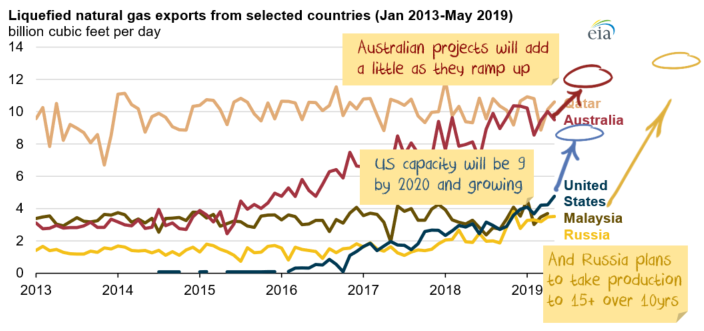Some welcome news for LNG producers as the spike in the oil price flows through to the gas price for many Australian producers due to contracts struck over a decade ago. However, it is a short term gain only, the LNG market is highly competitive and only going to get more competitive going forward – and the current major disconnect between oil and gas prices will likely accelerate the trend.
The big issues for LNG are:
- There is significant export competition coming
- US economics will cap LNG prices
- Australia has a perverse sensitivity to gas prices
There is significant export competition coming
Australia is about to be the world’s largest exporter of LNG, but how long that mantle is maintained will be kept is anyone’s guess as projects in the US and Russia come online:

Until recently the US has been unable to export gas. Since the export ban was removed a host of LNG trains have been built and more are coming.
Just this month the Russian Arctic LNG 2 project was given the official go-ahead – adding another 2.5 billion cubic feet per day. The owner of Artic LNG, Novatek, has plans to produce as much LNG as Qatar on its own.
There is a lot of supply.
US economics will cap LNG prices
A microcosm of the US economic problem is highlighted by the recent commissioning of a 2 billion cubic feet per day pipeline near Waha in Texas (noting from the chart above that the US exports a little over 4 billion cubic feet per day):

US regional gas prices are often lower than the benchmark Henry Hub price, and negative prices are not unknown.
The reason? US shale gas is usually a by-product. Energy companies are looking for oil, which is much higher value, but as part of the fracking process they often also produce gas which is then sold for whatever price the Energy company can achieve. Negative prices come when more gas is produced than the pipelines can handle and the Energy company will literally pay to have someone take the gas because the Energy company wants to extract the more valuable oil and the gas has to go somewhere.
The map below shows the recently completed pipeline and the new LNG export terminals:

And Waha is not the only region with this problem, Rystad (an energy consultancy) estimates the shale industry in the US “flares” more than 1.15 billion cubic feet per day of gas – i.e. just burns/wastes enough energy to power Australia.
My point is that there is a lot of cheap gas available for export from the US.
To give you an idea of the rough economics for the US to export to Asia:
- US gas prices are some of the cheapest in the world at $2-3 million British thermal units
- The cost to turn US Gas into LNG is another $3-4 million British thermal units – most of which is depreciation on the initial cost, i.e. not a cashflow.
- Shipping from the US to Asia is another $1-2 million British thermal units
So, the cash cost to get US gas to Asia can be as low as $3-4 million British thermal units, anything above that is a profit to pay back the cost of construction an LNG train. And this is what will cap LNG prices in the medium term.
Australia’s perverse sensitivity
As you can see from the first chart, Australia is about to be the world’s largest producer of LNG. As the (soon to be) largest exporter of LNG in the world, you would expect that this will support the Australian government budget. You would be wrong.
The Australian government makes so little revenue from LNG royalties that the negative effect of higher gas prices on industrial companies and electricity prices far outweighs the increase in tax revenue.
As both major parties had a hand in this situation, the issue gets little airplay as both sides are keen to avoid scrutiny.
I could write reams about how the world’s largest exporter also became one of the world’s most expensive gas markets, but I’ll save my rant for another time. The net macro effect is that higher LNG prices are, perversely, an economic drag on the Australian economy.
Investment outlook
Investing is as much about avoiding the losers as it is picking the winners.
LNG is looking like it is going to be a tough market, and that is before we even look at the effects of solar or wind power on the sector.
There are Australian LNG producers who are making hay at the moment on the back of higher oil prices. While this is a positive for those companies, given the economics of the sector this is a short term gain only – don’t expect this situation to last.

